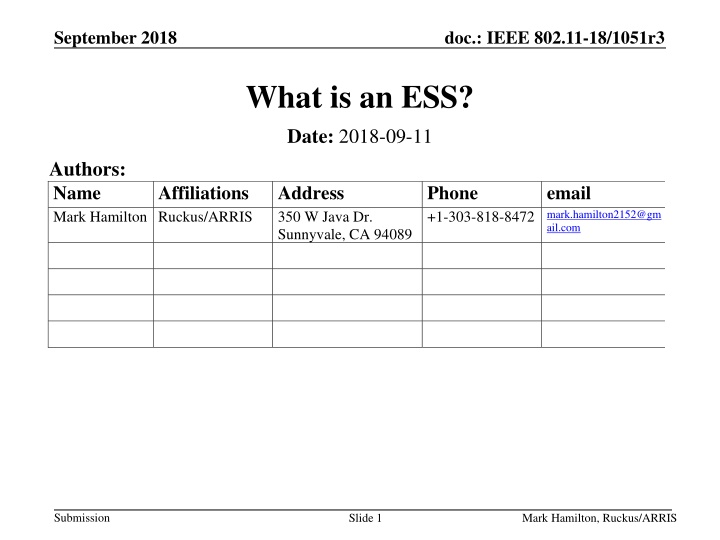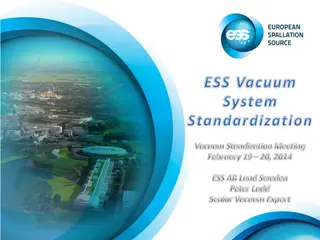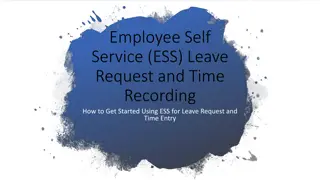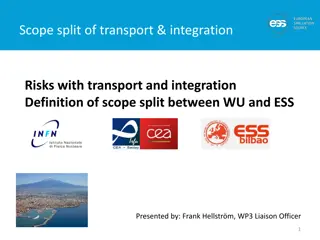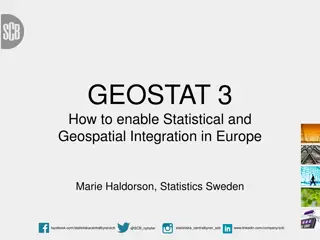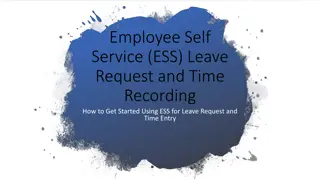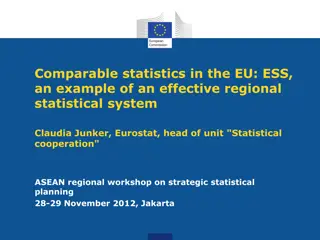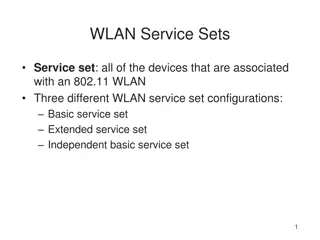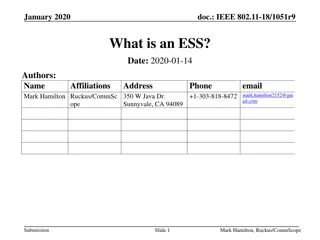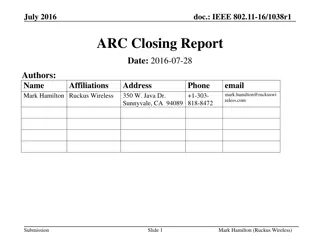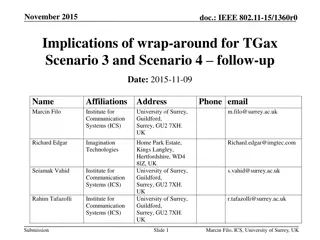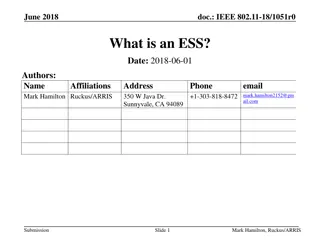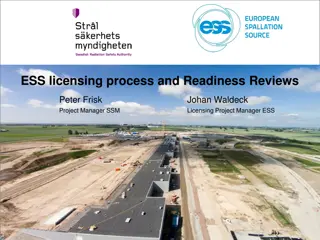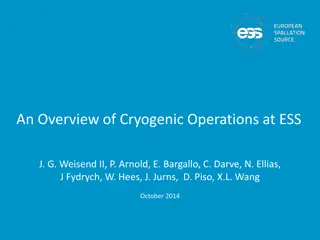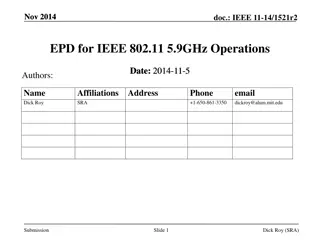ESS in IEEE 802.11-18
Delve into the concept of Extended Service Sets (ESS) within the framework of IEEE 802.11-18 standards. Explore the definition, characteristics, and implications of ESS in wireless network environments. Gain insights into how ESS plays a crucial role in enhancing connectivity and mobility for stations within a network.
Download Presentation

Please find below an Image/Link to download the presentation.
The content on the website is provided AS IS for your information and personal use only. It may not be sold, licensed, or shared on other websites without obtaining consent from the author.If you encounter any issues during the download, it is possible that the publisher has removed the file from their server.
You are allowed to download the files provided on this website for personal or commercial use, subject to the condition that they are used lawfully. All files are the property of their respective owners.
The content on the website is provided AS IS for your information and personal use only. It may not be sold, licensed, or shared on other websites without obtaining consent from the author.
E N D
Presentation Transcript
September 2018 doc.: IEEE 802.11-18/1051r3 What is an ESS? Date: 2018-09-11 Authors: Name Mark Hamilton Ruckus/ARRIS Affiliations Address 350 W Java Dr. Sunnyvale, CA 94089 Phone +1-303-818-8472 mark.hamilton2152@gm email ail.com Submission Slide 1 Mark Hamilton, Ruckus/ARRIS
September 2018 doc.: IEEE 802.11-18/1051r3 Abstract Ongoing discussion re: What is an ESS? Submission Slide 2 Mark Hamilton, Ruckus/ARRIS
September 2018 doc.: IEEE 802.11-18/1051r3 Goal of <x>SS discussion 802.11 needs to capture one or more types of STA mobility, and how each is communicated to the STA An <x>SS is a set of BSSs that have a common set of properties that a STA cares about. For example purposes, we consider/discuss <x>SS with at least two BSSs (== APs) so that we can discuss what is common and what is not. Chair recommendations: For each type/topic, capture a use case /purpose/context How many such contexts are there, really? How many such contexts are in our (802.11) scope? How many such contexts are already identified (ignoring what they are named)? Is there any gap or just confusion to sort? Submission Slide 3 Mark Hamilton, Ruckus/ARRIS
September 2018 doc.: IEEE 802.11-18/1051r3 What is an ESS? Current definition depends on the relationship to LLC A set of one or more interconnected basic service sets (BSSs) that appears as a single BSS to the logical link control (LLC) layer at any station (STA) associated with one of those BSSs. That would mean a 802.1 Bridged LAN (for example) creates an ESS. Probably not what we (802.11) meant. We probably meant something about transparency of location of attachment / mobility , from whatever is using the 802.11 MAC and other entities, necessary to accomplish this? ESS == demarcation of this transparency?? Is it: Transparent to whatever upper layer is above 802.11? Includes entities beyond (above?) 802.11? (Like bridges in the 11ak scenario?) The APs have to have some common/similar configuration settings? (SSID, at least. Probably other facilities (security, etc.) and policies?) Changes to Figure 4-1: BSS s are just STAs. These ovals are BSAs. Also, should we be saying OBSA ? Submission Slide 4 Mark Hamilton, Ruckus/ARRIS
September 2018 doc.: IEEE 802.11-18/1051r3 What is an ESS? (Continued) Current definition depends on the relationship to LLC A set of one or more interconnected basic service sets (BSSs) that appears as a single BSS to the logical link control (LLC) layer at any station (STA) associated with one of those BSSs. We probably meant something about transparency of location of attachment / mobility , from whatever is using the 802.11 MAC 802 Services includes other entities, necessary to accomplish this? (EAP Auth Service? Bridges (11ak)? ANQP, etc?) ESS boundary == demarcation of this transparency?? Yes, + common domain of mobility that works, including security, policy, etc., necessary for mobility that actually works. Is it: Transparent to whatever upper layer is above 802.11? No, boundary may be higher than that Includes entities beyond (above?) 802.11? (Like bridges in the 11ak scenario?) Yes, as needed The APs have to have some common/similar configuration settings? (SSID, at least. Probably other facilities (security, etc.) and policies?) Yes. Changes to Figure 4-1: BSS s are just STAs. These ovals are BSAs. Also, should we be saying OBSA ? Submission Slide 5 Mark Hamilton, Ruckus/ARRIS
September 2018 doc.: IEEE 802.11-18/1051r3 What is an ESS? Direction? Straw proposal - ESS is: [Edit this list, per discussion] Set of one of more basic services sets (BSSs) Appears as a single logical network, to layers above the ESS boundary The boundary might be above 802 (above Layer 2), or might be within Layer 2 (the MAC SAP, etc.) The boundary must exist/be clear for participating end stations (see 802 O&A), and external devices that can interwork with the participating end stations Provides transparency of location of attachment / mobility , as seen by layers above the ESS boundary, on both participating end stations and external end stations. Includes all entities necessary to provide the services and transparency required. Has a common domain of mobility and a common security and policies and configuration necessary to deliver the transparency from mobility. Submission Slide 6 Mark Hamilton, Ruckus/ARRIS
September 2018 doc.: IEEE 802.11-18/1051r3 ESS and HESS? What is an HESS (from the term HESSID )? Homogenous [sic] extended service set (ESS) Is an HESS a type of ESS, or a separate (perhaps similar) concept? MSGCF has an ESSIdentifier , which is the concatenation of SSID and HESSID. Why/when do we need both? Is this related to an SSPN? No not really the SSPN is independent of any HESSID assignment. SSPN is a destination where I am being taken to. See Figure R-2. (Also, in figure R-2 and Figure 4-8, the AAA server/client look to be in the data path this doesn t make sense. Ans, why are the BSSs not labeled BSSs?) Submission Slide 7 Mark Hamilton, Ruckus/ARRIS
September 2018 doc.: IEEE 802.11-18/1051r3 HESS concepts (not necessarily what 802.11 says, now) HESS purpose is to support 802.21 and/or WFA Passpoint/Hotspot 2.0 HESS is either/both consistent authentication, or equivalent access to external things HESS is identifiable by HESSID, which is globally unique (MAC Address); identifies the SP (but perhaps not one-to-one) HESS can/cannot span different ESSs or SSIDs Corollary: Which (if either) of these is related to 802.11 handoff? Homogenous is misspelled ; HESS should be introduced as a term/concept Submission Discuss off-line with WFA experts, 802.21 experts Slide 8 Mark Hamilton, Ruckus/ARRIS
September 2018 doc.: IEEE 802.11-18/1051r3 Needed concepts (not necessarily what 802.11 says, now) Looked at WFA s Deployment Guidelines: If two APs have the same SSID they are considered to be part of the same wireless network. But, because SSIDs are not globally administered it is possible that two APs with the same SSID are in fact in different wireless networks. HESSID element [sic] allows devices to detect this condition. What is wireless network in this context? Concepts we need: Domain for Reassociation (and upper-layer mobility transparency) Domain for same hotspot ( local ) Domain for hotspot from my [home] provider (worldwide) Domain that uses the same security Equivalent access to external things (SSPN?) (CAG?) Submission Slide 9 Mark Hamilton, Ruckus/ARRIS
September 2018 doc.: IEEE 802.11-18/1051r3 HESS concepts (not necessarily what 802.11 says, now) Homogeneous ESS attributes (should be): => Must have a globally unique identifier Set of BSSs Mobility transparency to upper layers (one DS, Reassociate) => Same HESSID => SSID is the same => all available/reachable services are the same => reachable SSPN(s) are the same, if present It s not: Submission Slide 10 Mark Hamilton, Ruckus/ARRIS
September 2018 doc.: IEEE 802.11-18/1051r3 Themes in examples (following slides) Example 802.1Q Bridged Network A Yes B Maybe C ?? One DS/ Reassociate Yes Maybe ?? FT Same RADIUS/SSPN Maybe Maybe ?? ?? Yes Same Accounting same thing, or different? ?? ?? Same security same thing or different? D E F Yes Yes ?? No Yes ?/ No Yes ?? Submission Slide 11 Mark Hamilton, Ruckus/ARRIS
September 2018 doc.: IEEE 802.11-18/1051r3 Example <x>SS ESS What does type A do/have? : Single 802.1Q Bridged Network That is: Same subnet There may be multiple subnets, but a given client sees a consistent subnet (or set of subnets it is using), as it moves around IP address(es) doesn t change with moving within <x>SS Transparency of location ( appears as a single BSS to UL ) One DS Can Reassociate Must have same SSID (careful!) (md 1.5 4.3.5.2) Can t necessarily FT between all APs (more than one mobility domain ) (not just because equipment is not capable/configured) Examples: Simple, well-known ESS ; 2 buildings far enough apart to not support FT (each building has its own mobility domain ); groups of APs where there is too much latency between the groups to handle FT; <x>SS subsetted to limit number of clients within each subset that can FT (each mobility domain has limited resource requirements) Submission Slide 12 Mark Hamilton, Ruckus/ARRIS
September 2018 doc.: IEEE 802.11-18/1051r3 Example <x>SS HESS (or close) What does type B do/have? : Access to the same authentication domain (RADIUS) same database (the same authentication server) Identified by (the WFA s) HESSID Not necessarily same subnet, etc. Access to the same SSPN (802.11u)?? Example: National/Worldwide chain of stores No assumption that there is a single SSID Discovery/Selection: SSPN information ( Roaming Consortium , Visited network , NAI Realm , etc.) Connection credentials: Submission Slide 13 Mark Hamilton, Ruckus/ARRIS
September 2018 doc.: IEEE 802.11-18/1051r3 Example <x>SS What does type C do/have? : Same accounting for use Need to return to this, remind ourselves of the use case/scenario that s different from type B Submission Slide 14 Mark Hamilton, Ruckus/ARRIS
September 2018 doc.: IEEE 802.11-18/1051r3 Example <x>SS What does type D do/have? : Single 802.1Q Bridged Network That is: Same subnet There may be multiple subnets, but a given client sees a consistent subnet (or set of subnets it is using), as it moves around IP address(es) doesn t change with moving within <x>SS More than one DS Can t reassociate across the DSs May or may not have the same SSID Example: A house with two, unrelated APs (different vendor, for example), plugged into the same Ethernet switch, with the same SSID. Not a .11 concept, but a composite of separate .11 networks and a .1 concept Submission Slide 15 Mark Hamilton, Ruckus/ARRIS
September 2018 doc.: IEEE 802.11-18/1051r3 Example <x>SS Mobility Domain What does type E do/have? : Single 802.1Q Bridged Network That is: Same subnet There may be multiple subnets, but a given client sees a consistent subnet (or set of subnets it is using), as it moves around IP address(es) doesn t change with moving within <x>SS One DS Can reassociate Can FT Must have same MDID Must have same SSID Submission Slide 16 Mark Hamilton, Ruckus/ARRIS
September 2018 doc.: IEEE 802.11-18/1051r3 Example <x>SS What does type F do/have? : Same/consistent layer 2 security parameters Coincidentally same security Planned/assured same security Not a useful concept in this discussion, just coincidental (sharing of same phone profile ) Submission Slide 17 Mark Hamilton, Ruckus/ARRIS
September 2018 doc.: IEEE 802.11-18/1051r3 Example <x>SS What does type G do/have? : Same Operating authorization domain (different, alternate concept:) Same operating master (e.g., DFS master, TVWS enabler, etc.) Not an <x>SS concept, but important as something else Submission Slide 18 Mark Hamilton, Ruckus/ARRIS
